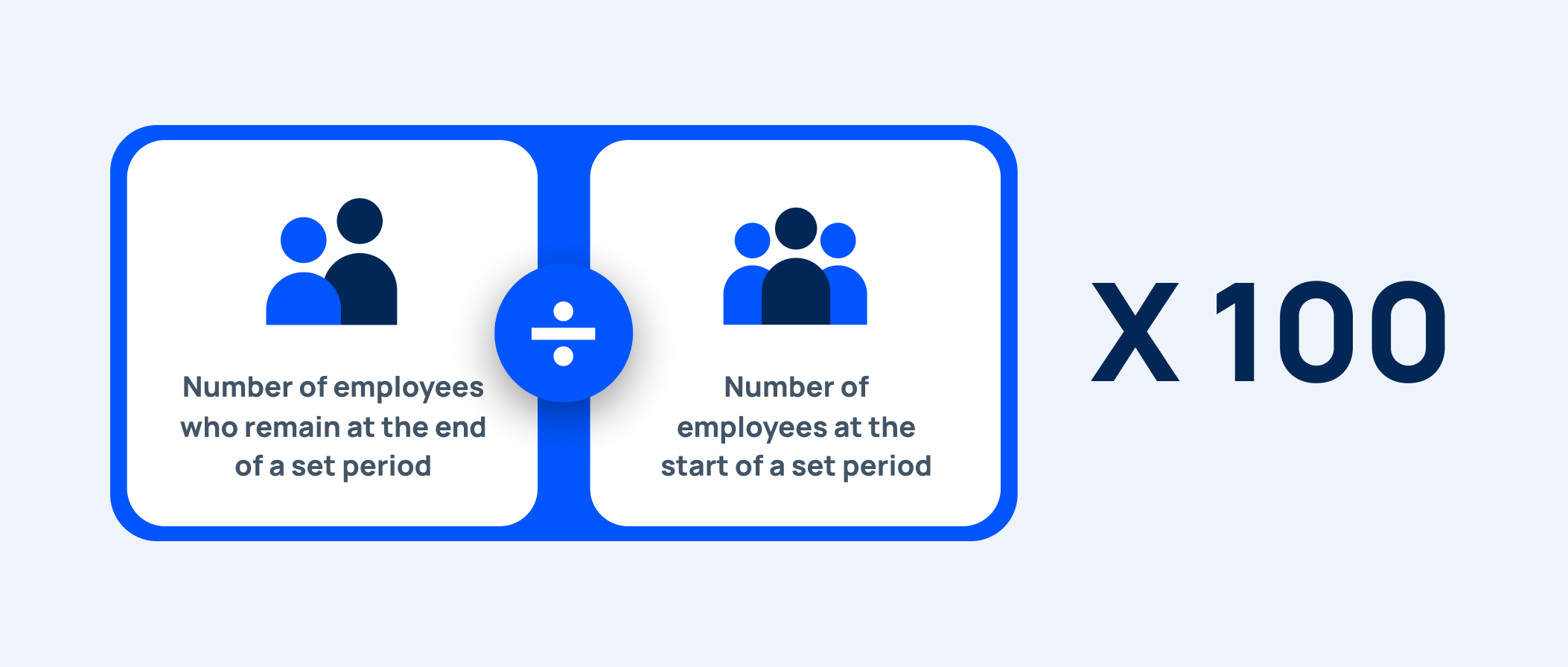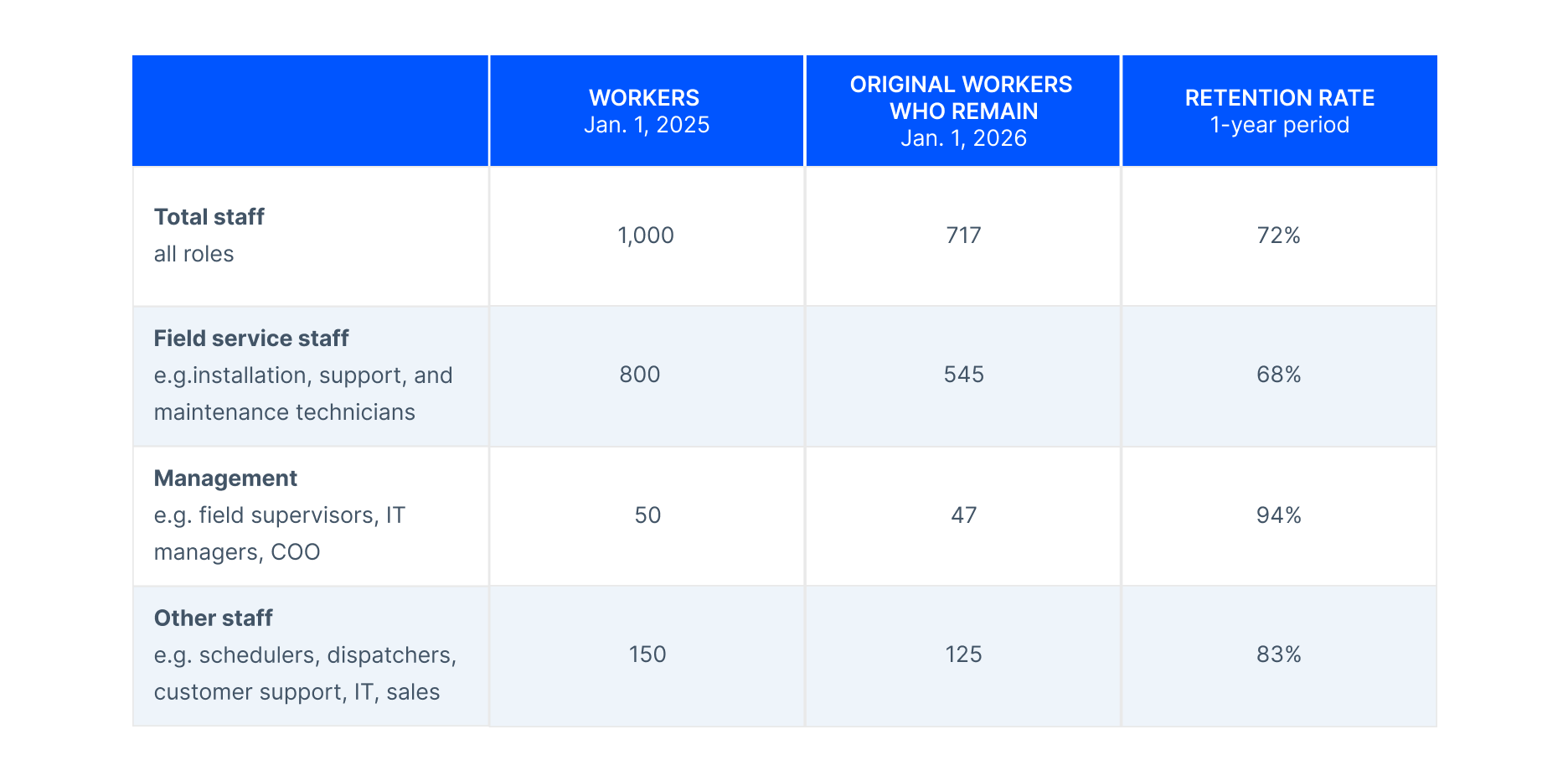Employee Retention: What It Means and How to Improve It
What is employee retention?
Employee retention is an organization’s ability to keep workers employed there over time. It’s also the name of the metric companies use to assess their success at retaining employees.
Typically, employee retention is expressed as a percentage and calculated with the following formula:
Employee retention strategies
Employee retention strategies are the methods and processes a company puts in place to prevent workers from quitting, i.e. to prevent employee turnover.
Retention is a complicated issue to tackle because so many different aspects of the employee experience come into play. On top of that, retention can look different from organization to organization depending on a variety of factors: industry, the structure of the company, whether or not work is seasonal, etc.
That said, there are still some proven best practices to improve staff retention that apply to nearly every business.
Hire the right people
One of the most effective—and most complex—strategies to improve employee retention is to hire the right people for the job. During the hiring process, be sure that your job posting lists the job description and duties very clearly. Also, be sure to provide an overview of the work environment and culture your company strives for. By being as clear as possible as early in the hiring process as possible, you improve your odds of attracting the right candidates who, hopefully, will become stellar employees.
Onboard new employees effectively
Once you’ve hired the right people, having a rock-solid onboarding process is critical for keeping them. According to a 2023 survey from BambooHR, employers have approximately 44 days to make a good first impression with new hires; most new employees know by this time whether or not they want to stick with a company. Additionally, new hires who go through a thoughtful onboarding process are three times as likely to commit to their organization.
Map out a helpful, logical sequence of onboarding tasks that go beyond getting their HR paperwork squared away.
- Set clear milestones and goals for their first month or so.
- Proactively set up regular meetings to check in on progress or any questions a new employee might have.
- Create a sense of psychological safety so they feel comfortable coming to you with roadblocks.
- Provide mentors and create opportunities for connecting with peers to give them a community beyond their manager to rely on for support.
Taking these steps makes all the difference in helping new hires feel supported and they’re not in a sink-or-swim environment that could have them looking to move on.
Offer training and development opportunities
As we mentioned earlier, ongoing professional development can make a difference in whether or not someone decides to stay employed with an organization. In fact, according to LinkedIn’s 2024 Workplace Learning Report, companies with a strong learning culture saw 57% more employee retention compared to companies that only had a mild or weak learning culture.
Ensure your workers have the right opportunities to hone their existing skills and also to develop new ones through upskilling or cross-training. For instance, if your business employs and oversees the scheduling of home healthcare workers for patients who need in-home care, you can offer additional training on chronic diseases, communication skills, and their observation and reporting skills. These skills not only improve patient outcomes, but help staff feel valued by enabling them to advance their careers.
Prioritize competitive compensation and benefits
One of the most common employee retention strategies is to ensure employees are fairly compensated with the right salary and benefits package. And it’s common for good reason: A 2021 report from Lattice found that at least 55% of people surveyed reported salary was a driver for their decision to leave a job.
To make sure your staff aren’t potentially looking elsewhere because of money, review compensation regularly—at least yearly—to keep up with market trends. Don’t forget about other benefits, too, such as time off; healthcare benefits like insurance and wellness credits or reimbursement programs; and retirement plans.
Track retention metrics
Of course, in order to truly know whether or not your employee retention efforts are working, it’s critical to keep track of retention metrics.
Start by determining what metrics are appropriate for your business. For example, in addition to overall employee retention, consider subcategories like manager retention or retention within a specific department.
This type of analysis can reveal better, more targeted solutions to operational questions. For example, consider a telecom company with the following metrics:
According to the data, field service teams saw significantly higher turnover than management (26% difference) and other staff (15% difference). At the current rate of turnover, the company should be prepared to replace over 250 field service workers per year to maintain the previous staffing level. This data point helps inform how the company prioritizes hiring, training, developing, and supporting the field service workforce.
Set a designated tracking start and end date that makes sense given whatever strategies you have in place and expected fluctuations. For instance, if seasonal hires make up a large portion of your workforce, you may not wish to include them in your retention metrics. And if you’re implementing a new strategy, like a new scheduling policy, in say, August, it may not make sense to start tracking in August; you may actually want to start tracking earlier to get a baseline for comparison.
Provide a nice working environment
Employees who don’t feel safe, happy, or welcomed at work will look elsewhere and eventually leave. Indeed, in an SHRM survey, three in 10 U.S. workers reported feeling irritable at home because of their workplace culture. And according to MIT Sloan Management Review, a toxic work culture can be 10.4 times more powerful of a predictor in an organization’s turnover rate than compensation. Clearly, businesses must ensure they’re providing a positive work environment and culture.
Ensure your staff feel supported across the board. Make sure managers regularly check in with direct reports to spur employees’ professional development and keep communication lines open. Provide ample opportunities for employees to connect through programs like team meals, optional after-hours get-togethers, mentorship programs, and more. Keep employees happy with reasonable accommodations like flexible schedule arrangements and wellness incentives.
Together, these actions can have a substantial impact on workers’ well-being and employee engagement, which makes them more likely to stay.
Communicate changes effectively
At the heart of nearly all of these employee retention strategies is good communication, particularly around change. Without it, it’s next to impossible to improve operations, staff at all levels would become frustrated, and employee turnover rates would rise. To this point, a 2022 report from ZenHR found that organizations with successful team communication increase employee retention by 4.5 times more than organizations that struggle with effective communication.
To avoid communication becoming a driver of staff turnover, be clear across all levels of work. That means keeping employees clearly informed both of high-level items like shifts in company and department goals and of more day-to-day priorities such as which projects and clients require more focus at any given time.
Make sure communications about these items are unambiguous and timely. Use available technologies and platforms, such as a company intranet or an internal resource center, to make sure employees can access the information on their own schedule.
Additionally, provide appropriate channels for people to ask follow-up questions. That might look like a mix of having regular one-on-one meetings between managers and direct reports; weekly department meetings; and utilizing instant messaging for quick, more specific questions that pop up during day-to-day work.
Support workers with the right technology
Finally, another surefire way to tamp down on turnover is to make sure your teams have the tools they need to do their best work. Take a look at processes and operations to make sure there aren’t any unnecessary or overly complex steps that could be slowing employees down or leading to preventable errors—and leverage tools and technology to make day-to-day tasks easier.
For instance, a plumbing company requires a client signature after each job is complete, and the plumber must file that signature in the company database. Make your employees’ lives easier by providing technology that captures signatures digitally and then automatically uploads them to a digital database so your team members can get a signature fast and move on to more pressing items.
Or consider this scenario: for a solar panel installation and maintenance company, scheduling workers has become a challenge due to an increase in emergency maintenance appointments. In turn, team members keep getting assigned to jobs that are far from their route for the day. To make employee’s lives easier and cut down on unnecessary travel time, leverage a scheduling platform that makes staffing suggestions based on factors like the location of your technicians, balanced with other decision-making factors. That way, team members don’t have to deal with the stress of battling traffic and longer drive times trying to get to job sites on time unless they are truly the only worker qualified for the job. As a result, they have a more pleasant work experience and are more likely to stay at your company.
Want to learn more about how to support a mobile workforce with the right technology? Learn how Skedulo has helped customers improve staff retention.
Employee retention FAQ
What is employee retention?
Employee retention refers both to the strategies an organization might use to prevent staff from leaving and also the metric that directly measures the percentage of employees a company has managed to retain over a set period of time.
How do you improve retention numbers?
Some strategies for improving employee retention will depend on things like what industry your business operates in, your customer base, and more. Generally, though, tactics that work for most companies include: strong internal communication, providing the right tools for workers , hiring the right people, having thoughtful onboarding and professional development processes in place, tracking retention metrics effectively, and prioritizing compensation and culture.
What are the main causes of employee turnover?
The causes of employee turnover can be complex and layered, but there tend to be common causes that spur workers to quit. Dissatisfaction with compensation and benefits is a popular reason for turnover, as well as displeasure with the company culture and work environment. Other frequent sources for attrition include a desire for better work-life balance and for better opportunities for professional development.







